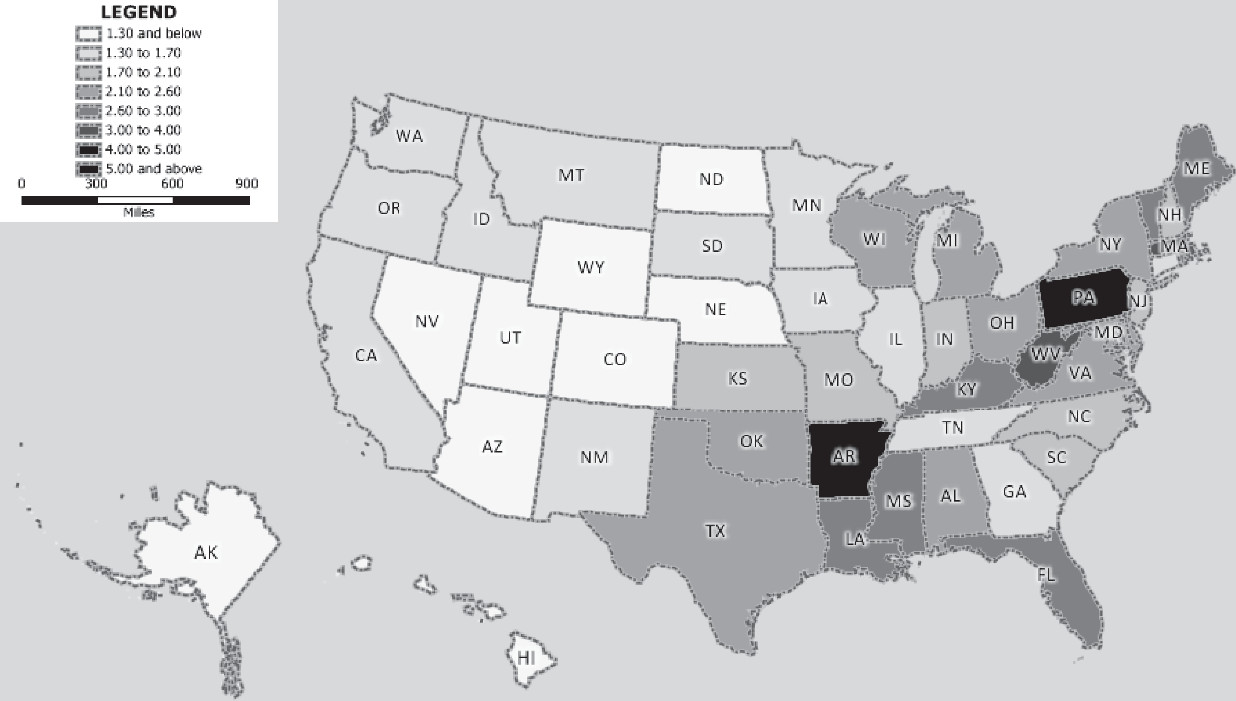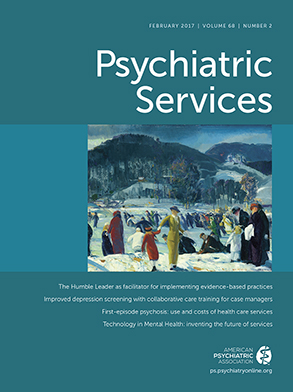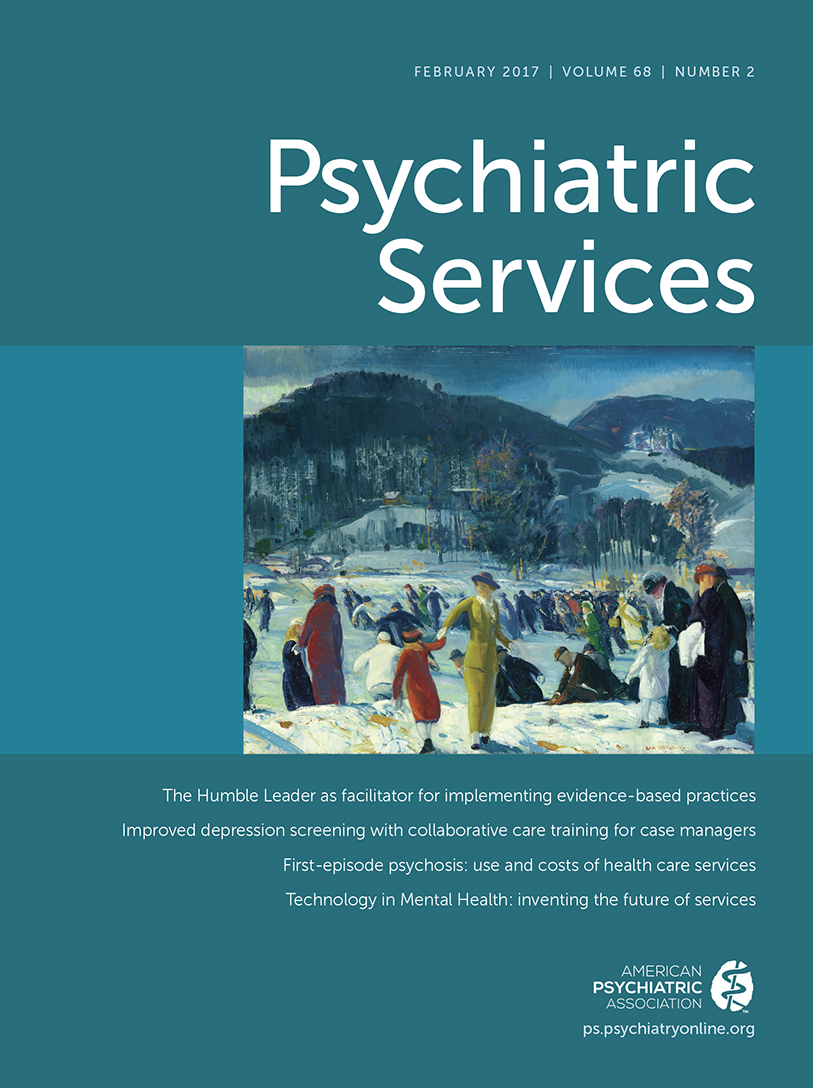The Supplemental Security Income (SSI) program is one of the few federal programs to provide monthly cash assistance to low-income families of children with mental disabilities that result in severe impairment. SSI eligibility often improves access to mental health services because it ensures referral to state Title V programs and, in most states, qualifies children for Medicaid.
The prevalence of child psychiatric disorders has been relatively constant (
1). Thus an increase in the number of children receiving SSI benefits for attention-deficit hyperactivity disorder (ADHD) in recent years has led to media attention and a Government Accountability Office report (
2). In response, the Social Security Administration commissioned the National Academies of Science, Engineering, and Medicine (NAS) to examine recent growth in the number of low-income children with mental disabilities served by the SSI program (
3). The full report describes features of the national context that may contribute to the rise in SSI benefits for these children (
4). Summaries of the main results of this report are also available (
5–
9).
Federal entitlement programs, such as SSI, provide personal financial benefits to beneficiaries who have a legal right (enforceable in court, if necessary) whenever they meet eligibility conditions that are specified by the standing law that authorizes the program. There are few entitlement programs for children with mental disabilities. These children are known to be significantly underserved (
10). Eligibility for benefits has the potential to equalize access to services. State-to-state variations in administration of entitlement programs raise fundamental ethical as well as practical questions about why eligibility should differ on the basis of state residence. Therefore, the objectives of this study were to examine variation by state in the rates of SSI determinations, allowances, and receipt of benefits for ten selected childhood mental disabilities as of 2013 and to describe ten-year trend data (2004–2013) in SSI determination rates among low-income children (those living in households below 200% of the federal poverty level (FPL). (SSI uses the term “mental disabilities.” These include psychiatric or mental disorders as well as developmental and intellectual disabilities. We use the term “mental disabilities” in this report to be consistent with SSI terminology.)
Methods
The NAS committee focused on ten mental disabilities: ADHD, oppositional defiant disorder, conduct disorder, autism spectrum disorders, intellectual disability, borderline intellectual function, mood disorders, learning disabilities, organic mental disorders, and anxiety-related disorders. These were selected because they are the highest-frequency diagnoses associated with SSI allowances and are included in the SSI list of mental disabilities.
Data on SSI determinations, allowances, and recipients for these ten disabilities from 2004 to 2013 were provided by the Office of Disability Policy Management Information and the Office of Research, Evaluation, and Statistics. Determinations refer to the total number of applications reviewed to determine whether an applicant meets financial eligibility and criteria for severe impairment. Allowances refer to the percentage of determinations in which the individual was found to be severely disabled. The term “recipients” refers to all children who were cumulatively eligible during a given year—that is, who were newly deemed or continued to receive cash assistance, irrespective of when they became eligible.
The absolute number of determinations and recipients varies between states because of differences in state population sizes and the number of low-income children in each state. Accordingly, we generated state-specific rates, taking into consideration both the total population size and the estimates of the number of low-income families, by using data from the U.S. Census Bureau 2015 Current Population Survey. For each state, we estimated the number of children under age 18 and living in households below 200% of the FPL (from 2004 to 2013) as a proxy for the number of children who were income-eligible for SSI. This served as the denominator to calculate state-specific determination, receipt, and eligibility rates in 2013.
Results
The 2015 NAS report,
Mental Disorders and Disabilities Among Low-Income Children, found that approximately 1.3 million children received SSI disability benefits in 2013, representing 1.8% of all U.S. children (
3). Of these beneficiaries, about 50% received benefits as a result of mental disabilities.
State-specific rates of determinations for the ten mental disabilities varied by a factor of 5.7, ranging from a high of 1,441 per 100,000 income-eligible children in Pennsylvania to a low of 251 per 100,000 in Nevada. [A figure in an online supplement to this report presents these data.]
The rate of determinations also varied, with western states lower than eastern states. A cluster of states with low determination rates was found in southeastern states, whereas high determination rates clustered in northwestern and western states.
In Georgia, 16% of applications for SSI benefits for the ten mental disorders were approved, in contrast to 78% in Alaska, a fivefold difference. Nationally, this rate averaged 37%; it was greater than 50% in 13 states and less than 25% in seven [see online supplement].
The percentage of low-income children who are recipients in a state is an indicator of the coverage of the SSI program for children with severe mental disabilities in that state. In 2013, .7% of low-income children were recipients in Hawaii, and 5.3% of low-income children were recipients in Pennsylvania; this is a 7.6-fold difference [see online supplement].
Figure 1 is a map of the variations in percentages of poor children who were recipients of benefits for the selected mental disabilities across states.
Between 2004 and 2013, the average annual rate of determinations for low-income children in the United States decreased 2%. Here again, there were significant state variations. The rate of determinations in Rhode Island increased by 48%, from 584 per 100,000 low-income children in 2004 to 864 per 100,000 in 2013. In Utah and Texas, it increased by 32%, and in Connecticut, it increased by 31%. In other states, such as Minnesota, North Dakota, Kansas, and Nevada, the determination rate decreased by at least 33% [see online supplement].
Discussion
The NAS committee was not asked to nor did it examine the reasons for the large discrepancies across states. Nevertheless, the administrative data provided by the SSA show wide variation by state in determination, allowance, and receipt rates of SSI benefits for child mental disabilities. Ten-year trends in determination rates also varied substantially across states. The probable consequence of these inconsistences is that the likelihood of receiving SSI benefits for children with severe mental disabilities depends on the state of residence: a child is likely to become a recipient of SSI benefits if he or she lives in one state but will be denied benefits if he or she lives in another. This is an inequity in both the spirit and the implementation of this federal entitlement program.
Variations have been found in other service programs for children with health and mental health needs. For example, an analysis of data from the 2007 National Survey of Child Health found a threefold difference in rates of child mental health issues between states with the highest and lowest rates (
11). Similarly, variations in rates of special education services for emotional disturbance—as defined by IDEA education legislation, a federal entitlement program for special education services—differed 33-fold across states (
12,
13). This variation occurred despite a federally mandated definition of emotional disturbance.
It is important to note that the issue of inequity is different from the issue of low or high rates. It is unknown what the “correct” rate of determinations, allowances, or receipt for SSI benefits might be. Although estimates of the prevalence of each of the ten mental disabilities are discussed in the NAS report, the issue of equity in implementation is different from the issue of whether a rate is low or high.
Nevertheless, these variations violate the spirit of federally mandated programs for children with special needs. Factors that may contribute to this variation include differences in the determination process, state policies, and external factors outside the administration of the SSI program. The process of determining eligibility for services in the SSI program is unique and is not based on standardized measures of diagnoses and impairment that are often used in epidemiologic studies or national surveys of child health. When a parent applies for and is given a tentative diagnosis, SSA develops a case portfolio, based on medical and other records, to confirm or change the diagnosis and to determine whether it meets the SSA-defined definition of disability. These evaluations are carried out at the state level by state Disability Determination Services (DDS). Although states use national standards with oversight by the SSA, they do not physically examine the child, although they may request examinations and testing. Furthermore, an assessment of severity is necessary to determine the extent of the disability, irrespective of the specific diagnosis. Those who apply for SSI often have multiple disabilities, and it is often easier to make the determination on the basis of one rather than another. This process itself may contribute to inconsistencies in implementation of program requirements.
In 2015, the Office of the Assistant Secretary for Planning and Evaluation of the U.S. Department of Health and Human Services examined state variations in SSI pediatric caseloads (
14) and concluded that regional, state, and local factors likely influenced program growth. Factors that might affect the variation included advocacy groups and their power to influence policies, differences in state economies that affect the opportunities of parents and youths to obtain public assistance, demographic variations, and state DDS review processes, which provide latitude in compensation, hiring of examiners, and use of private contractors.
It is also possible that state-specific policies affecting implementation of public benefit programs may influence state rates. For example, SSI benefits may be substituted for Temporary Assistance for Needy Families (TANF) benefits in some states, and TANF uses state dollars. Prior analyses by SSA of adult allowance rate variation suggest that about half of the variation might be explained by factors external to the program, such as numbers of applications and insurance coverage.
Conclusions
Given that income supports are likely to improve long-term mental health outcomes for children (
15), interventions to ensure greater consistency in the implementation of the SSI program may have a large effect on the future health of children with mental disabilities living in poverty. There is an ethical argument for ensuring that the spirit of federal entitlement programs is reflected in more equitable access to these programs. Eligibility and receipt of benefits should depend not on state residency but rather on consistent implementation of program benefits.


